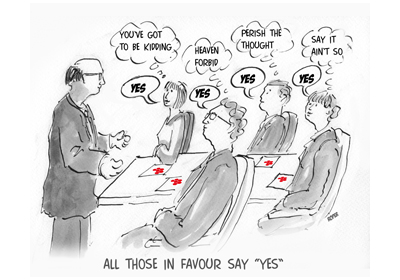A term invented in 1972, Groupthink is a mode of thinking we engage in when we’re deeply involved in a cohesive, task-centred group – or when our need for agreement supersedes our need for a decision based on rational information.
Groupthink can lead to bad judgments and potentially disastrous decisions, and can also cause us as a group of decision makers to rationalise poor decisions after the fact. It’s a simple and totally inadequate way to deal with difficult issues.
Although discord and conflict among individuals is a major pitfall among decision-makers, Groupthink is equally dangerous. Group cohesiveness is a good quality and something we all groups strive for, but Groupthink takes this cohesiveness to the extreme. One client recently said to us, “It’s terrifying to see how people all line up behind the key influencers [in this team] without ever questioning the decision, or the basis on which it’s being made”.
We often resort to Groupthink when we’re collectively under pressure to make a decision. Ironically this happens in organisations at the most crucial time – when strategic decisions need to be made to satisfy corporate leaders or shareholders.
So what can you do to avoid Groupthink? There are a number of actions that can help:
- Notice when Groupthink is happening and point it out to the group – its causes and, especially, its consequences.
- If you’re going against the group it helps to make this explicit by saying something like, “this may annoy some of you but…/I know this is going against the way we are thinking at the moment but..”. You are much more likely to be heard sympathetically rather than ganged up on by the group trying to maintain its path.
- Ahead of time, appoint someone to play “devil’s advocate” and challenge the group, looking for flaws in logic, false inferences and overlooked information.
- Test your thinking. Get out of your cocoon and ask questions of those who will be impacted by the group’s decisions. Pick up the phone, call a customer, or walk around and get a reality check! Encouraging feedback on what worked and what didn’t about previous decisions will also help keep your feet on the ground. Ask group members to get feedback from their own constituents before a final decision is made.
- Create one or more independent decision-making groups with different leaders to work on the same critical issue or policy, then bring the sub-groups together to hammer out differences of data, assumptions and solutions.
- Get the group to make a formal presentation (including their data, assumptions and conclusions) to its leader (and possibly to his/her manager too). Have the group evaluate their decision-making process as part of the presentation.
- If you are the leader, avoid stating preferences and expectations at the outset. In doing so, you create pressure for others to agree.
- As a leader, encourage dissent and alternative comments. Remind everyone that open and frank communication is essential to good decision making and a healthy culture.
- If the decision is particularly important, or you think your decision-making process needs a fresh pair of eyes, ask a facilitator to be a ‘fly on the wall’ and give you feedback, or to lead the group through the process.
Has this made you think? Then do let us know your thoughts by commenting below or contacting us at info@leaderslab.co.uk.
